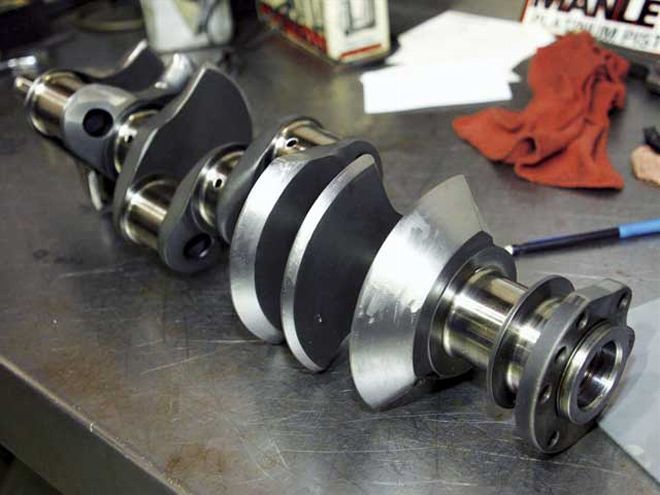
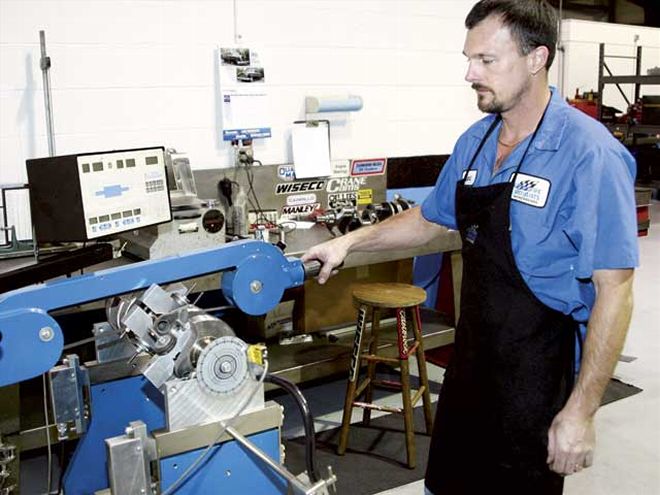 In addition to causing unnecessary failures in the main bearings, a raceengine that isn't balanced properly can cost you power.
In addition to causing unnecessary failures in the main bearings, a raceengine that isn't balanced properly can cost you power.
When it is powering a race car--with all the rumbling, vibrations,beating, and banging going on--it can sometimes be easy to forget thatthe engine is a precision piece of equipment. In the hands of the rightengine builder, all the moving pieces are as finely tuned and move withthe precision of the proverbial Swiss watch.
That's a good thing. Because of the rpm being turned by race engines,any unbalance can have severe results. Two decades ago, if one pistonand rod combination was heavier than the rest, it usually wasn't aproblem. The entire mass of the rotating assembly was so much that adifference of 10 or more grams didn't make much difference. Today,however, component manufacturers are pushing the design limits ofhigh-strength/low-weight components; a piston and rod combination thatis just a few grams too heavy or light can mean ruined bearings, shearedflywheel bolts, and worse. That's why properly balancing your raceengine's rotating mass is more important than ever before.
Calculating Weight
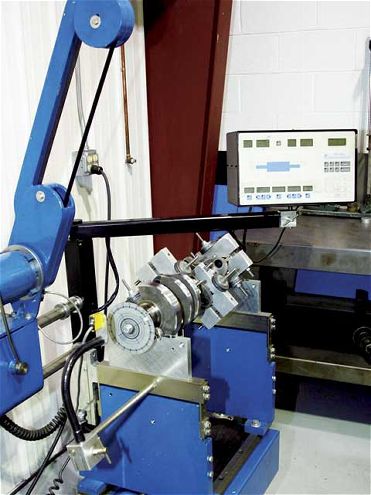 Here, the small end of the rod is being weighed to help determine thereciprocating weight. As you can see, the rod is assembled when it isweighed. A stationary arm suspends the end that isn't being weighed overthe scale.
Here, the small end of the rod is being weighed to help determine thereciprocating weight. As you can see, the rod is assembled when it isweighed. A stationary arm suspends the end that isn't being weighed overthe scale.
Part of the difficulty with understanding how to balance an engine'srotating weight is this: Not all of it rotates. Yes, the crankshaftspins, but don't the pistons and part of the rods move up and down? Howdo you balance it all out?
The answer is actually a very simple calculation. When calculating theweight that is to be attached to the crank, the rod bearings and the bigend of the rod are considered rotating weight. The small end of the rod,piston, wristpin, rings, and pin locks are all considered reciprocatingweight (instead of spinning around, it moves up and down).
Typically, 100 percent of the rotating weight and 50 percent of thereciprocating weight are added together to form the total for the bobweight. Some engine builders include four or five grams in the total tosimulate the weight of oil clinging to the various parts. The bobweights are actual weights that are attached to the crank's rod journalsto simulate the weight of the rod/piston assembly. With the bob weightsin place, the crank is ready to be spun on a balancing machine.
Understanding Overbalance
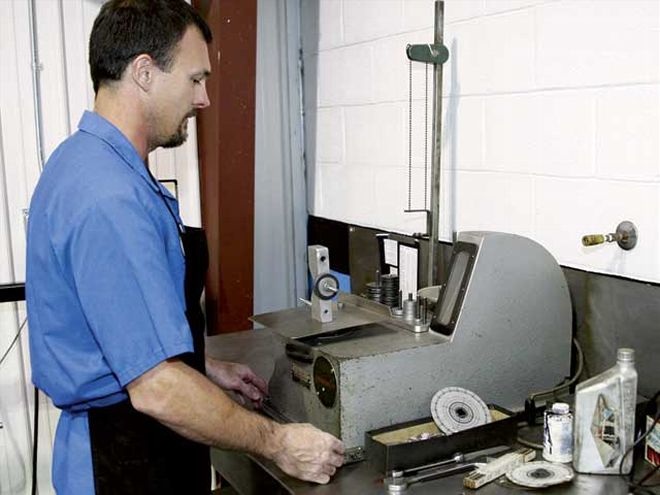 Earl Mark of Automotive Specialists checks each half of a bob weightindividually to make sure that the total weight is correct, but alsothat both sides of the bob weight are equal.
Earl Mark of Automotive Specialists checks each half of a bob weightindividually to make sure that the total weight is correct, but alsothat both sides of the bob weight are equal.
If you have hung around engine shops, then you may have heard that acrank has been "overbalanced." You may have even heard the phrase "underbalance," but hopefully never in association with a circle track racingengine. Overbalancing is when the percentage of the reciprocating weightis increased by a couple of percentage points when calculating the bobweight. The idea is that this reduces high-rpm vibrations.
"There are always two critical imbalances in any V-8 engine," explainsKeith Dorton, owner of Automotive Specialists. "Normally, there's alow-speed and a high-speed imbalance. Properly balancing the crankshaftreduces it, but it doesn't get rid of it.
"My first experience with overbalancing was early in my career withmotorcycle engines. They were high rpm engines, and we were getting upto 60 to 70 percent overbalance on them to keep the high-rpm vibrationsdown.
"One of the first applications I remember overbalancing a V-8 was wayback in the '60s on a big-block 427 Ford that was drag racing in the AGas class. Back then, it was making somewhere around 570 to 580horsepower.
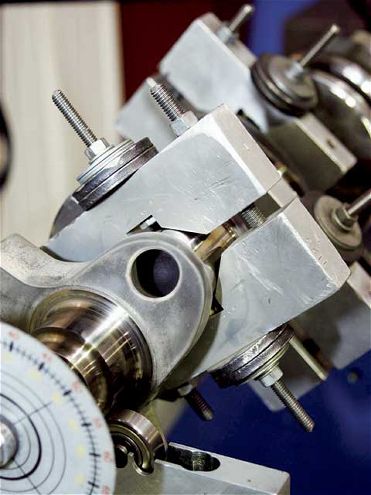 Bob weights, which simulate the weight and motion of two rods, twopistons and the rest of their associated parts, are attached to each ofthe crank's four rod journals.
Bob weights, which simulate the weight and motion of two rods, twopistons and the rest of their associated parts, are attached to each ofthe crank's four rod journals.
"The racer that ran the car was pretty much ahead of his time. Backthen, the NASCAR guys were running their engines to 7,000 or at most7,200 rpm, but this guy was turning a big-block close to 8,000 in adragster. We balanced his rotating assembly using common practices forthe time--50 percent reciprocating weight and 100 percent rotatingweight. But he complained that when he really got the thing going inhigh gear, right before he got to the lights, the engine startedvibrating so badly it actually blurred his vision.
"The high-rpm vibration was vibrating things off the car. In the shortamount of time the car was on the track, the vibration wasfatigue-cracking the sheetmetal valve cover and the intake manifold.Plus, this driver had a really good feel for the car, and he could tellthat when the engine got into this vibration, it was also laying down.
"So we brought the engine back in and overbalanced the crank. Weoverbalanced it at 52 percent (each bob weight weighed 100 percent ofthe rotating weight and 52 percent of the reciprocating weight), and itreduced the high-rpm vibration substantially. The next time we had it inthe shop, we brought the overbalance up to 53 or 54 percent and thathelped it even more. The change caused a pretty violent vibration in thelow-rpm range. I think it was between 3,000 and 4,000, but that wasn't aconcern because we weren't racing there. The change didn't just reducethe high-rpm vibrations. It decreased the elapsed time on the track,which is what we were really after."
For circle track racing, Dorton says that most engines are onlyoverbalanced by a couple of percentage points. That's because an ovaltrack car, especially for short tracks, will have to pull through a widerange of rpm. Although the engine may rev beyond 9,000 rpm, it will bein that range only for brief moments at the end of the straights. Moreimportant is how well the engine pulls at much lower rpm when the car isaccelerating out of the turn. The goal is to adjust the components sothat the critical vibrations fall at rpm levels below and above yournormal operating range.
 If your rules allow it, another option for removing metal is to anglethe counterweights like this. The idea is that the knifed edges reducewindage in the oil pan.
If your rules allow it, another option for removing metal is to anglethe counterweights like this. The idea is that the knifed edges reducewindage in the oil pan.
Piston and Rod Balancing
The first step in balancing an engine is weight-matching all the pistonsand rods. To do this, all the components are weighed. The entire pistonassembly, complete with rings and locks, can be weighed together, butthe rods must be weighed in two stages. The small end and the big end ofthe rod must be weighed separately, since the small end falls under thereciprocating weight category while the big end is rotating weight. Seethe accompanying photo for how this is done.
 When all the bob weights are correctly assembled and installed on thecrank, a balancing machine can tell you exactly where on the crankweight needs to be either added or removed.
When all the bob weights are correctly assembled and installed on thecrank, a balancing machine can tell you exactly where on the crankweight needs to be either added or removed.
Now, compare the weights of the same components (for example, the smallend of the rods). If they don't all weigh the same (within the range ofa gram), the heaviest rods must have material cut away until they arethe weight of the lightest rod. The same goes for the pistons and largeend of the rods.
Fortunately, this practice only applies if you are racing with stockcomponents. Today, almost all race-quality aftermarket components comeweight-matched. Other than a quick check on the scales to make sureeverything is OK and determine your bob weights, there is nothing foryou to do. "With lightweight racing pistons and rods, there really isn'tany place you can remove material without harming the integrity of thecomponent," Dorton says. "If you have a rod or piston that is way out ofline on the weight, what you really have is an issue with yourmanufacturer."
Crank Balancing
Once the pistons and rod ends are all equal, the bob weights can bedetermined. With the bob weights attached to the crank's rod journals, abalance machine is used to specify exactly where the crank needs to beworked to bring it into balance. Whether they are forged or billet, mostracing crank manufacturers can ship you a crank that's almost perfect ifthey know the component weights ahead of time. Weight is almost alwaysadded on the outermost throws because it makes the most difference inthose locations.
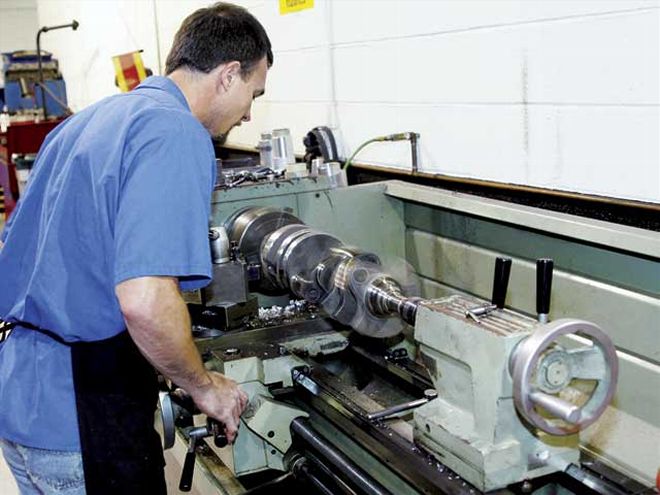 Instead of drilling holes in the ends of the counterweights, AutomotiveSpecialists prefers to turn down the ends of the counterweights in alathe.
Instead of drilling holes in the ends of the counterweights, AutomotiveSpecialists prefers to turn down the ends of the counterweights in alathe.
A crank is brought into balance by either adding or removing weight inspecific places. Since you don't want to increase the dimensions of thecrank's counterweights, adding weight is done by drilling out holes inthe counterweights that run parallel to the crank's centerline andinserting slugs of "mallory metal." Mallory metal is a tungsten alloythat is 1.5 times heavier than lead, and a little goes a long way whenbalancing a crank.
The other method is to reduce weight. Many shops do this by drillingholes into the ends of the counterweights. This works fine, except manyengine builders feel that the unevenness created in the ends of thecounterweights increases windage. Dorton prefers to turn the ends of thecounterweights down in a lathe so that the outside diameter (o.d.) ofthe crank is actually reduced. Final adjustments are done with a handgrinder and a light touch. This takes more time, but the end result is aracing crank with a smoother outer surface.
Calculating Bob Weights
Calculating bob weights isn't difficult, but it does require a littletime at the scales. Here's the complete list for determining your bobweights for zero-balancing a crank.
Rotating Weight
* Big end of rod (including fastening hardware)
* Bearing
* Oil (normally estimated at four grams)
Reciprocating Weight
* Piston
* Wristpin
* Pin locks (if used)
* Small end of rod
* Piston rings
Bob weight = Rotating Weight + (Reciprocating Weight x .50)
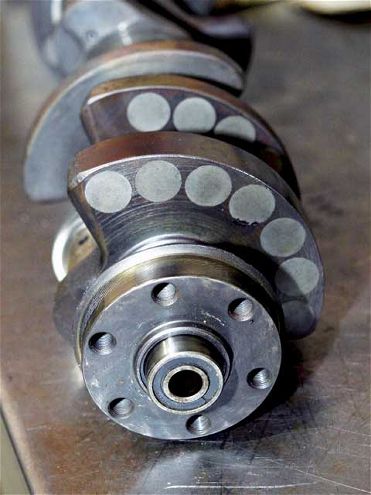 This crank is essentially junk, but you can see the many slugs ofmallory metal that have been pressed into the counterweights. It was aneffort somebody made to match up a crank that is too light with pistonand rod assemblies that were too heavy.
This crank is essentially junk, but you can see the many slugs ofmallory metal that have been pressed into the counterweights. It was aneffort somebody made to match up a crank that is too light with pistonand rod assemblies that were too heavy.
Internal versus External Balancing
So far, all of our discussion on balancing has included only the crank,pistons, rods, and the other various pieces that go into thoseassemblies. This is known as an internally balanced engine. The otheroption, an externally balanced engine, also includes the flywheel andharmonic damper. In this situation, both the flywheel and damper areinstalled on the crank when it is dynamically balanced on a balancingmachine. Instead of modifying the crankshaft to achieve balance, weightsare welded to the flywheel and/or the damper.
An externally balanced engine runs just as well as an engine that hasbeen internally balanced, but this method isn't nearly as popular inracing. First, Dorton points out that if the damper were to break orcome off, the main bearings could be damaged in a very short period oftime. Then, instead of replacing just the damper, you would be lookingat a complete engine rebuild. Second, because both the damper andflywheel are integral to the engine's balance, if either need to bereplaced, the entire engine must be rebalanced. This isn't necessary inan internally balanced engine.